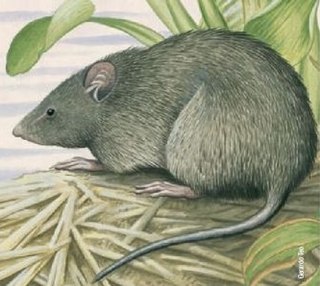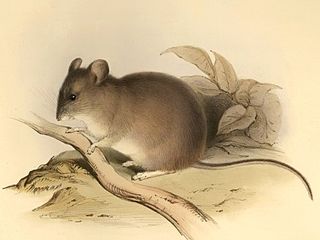
The family Chinchillidae is in the order Rodentia and consists of the chinchillas, the viscachas, and their fossil relatives. This family is restricted to southern and western South America, mostly living in mountainous regions of the Andes but one species living on plains. They are medium to large-sized rodents, weighing from 800 g (28 oz) to 8 kg (18 lb), with strong hind legs and large ears and a bushy tail. All species have thick, soft fur, which is considered valuable in some cultures.

Oxymycterus is a genus of rat-like rodents commonly known as hocicudos. They are endemic to South America. As of April 2019, the genus contains the following 16 species:
The Serra do Mar grass mouse or Cerrado grass mouse is a rodent species from South America. It is found in Brazil.

The gray leaf-eared mouse is a rodent species from South America. It is found in Argentina, Bolivia, Brazil and Paraguay; its habitat includes the Gran Chaco.
The lesser Wilfred's mouse is a species of South American rodents of the family Cricetidae. It was first described by Wilfred H. Osgood under the name Thomasomys pictipes, then into the genus Wilfredomys, and now known as Juliomys pictipes. The lesser Wilfred's mouse is endemic to northeastern Argentina and southeastern Brazil. Its physical appearance ranges from dark brown to light orange coloration and the typical size is small to medium. This species is arboreal, spending most of its time trees and living in the local forests at altitudes from sea level to 2000 m. Currently, this species is listed as Least Concern by the IUCN, but, threats include livestock farming, ranching, and wood harvesting.

Abrothrix longipilis, also known as the long-haired grass mouse or long-haired akodont, is a species of rodent in the family Cricetidae. It is endemic to central Argentina and Chile. Until 2014 it was thought that the species extended into southern Chile and Argentine Patagonia but these populations are now proposed to belong to closely related species named Abrothrix hirta.
Abrothrix olivacea, also known as the olive grass mouse or olive akodont, is a species of rodent in the genus Abrothrix of family Cricetidae. It is found from northern Chile into southern Chile and Argentina, including the islands of Tierra del Fuego. It is prone to large swings in population size.

Akodon spegazzinii, also known as Spegazzini's akodont or Spegazzini's grass mouse, is a rodent in the genus Akodon found in northwestern Argentina. It occurs in grassland and forest at 400 to 3,500 m above sea level. After the species was first named in 1897, several other names were given to various populations now included in A. spegazzinii. They are now all recognized as part of a single, widespread and variable species. Akodon spegazzinii is related to Akodon boliviensis and other members of the A. boliviensis species group. It reproduces year-round. Because it is widely distributed and common, Akodon spegazzinii is listed as "least concern" on the IUCN Red List.

Abrothrix is a genus of rodent in the tribe Abrotrichini of family Cricetidae. It contains the following living species:
Morgan's gerbil mouse, also known as the western Patagonian laucha, is a South American species of rodent in the family Cricetidae. It is named for J. P. Morgan, one of the sponsors of the expedition that first identified the species.
Irenomys tarsalis, also known as the Chilean climbing mouse, Chilean tree mouse, or long-footed irenomys, is a rodent found in Chile, from about 36° to 46°S, and in adjacent Argentina, mainly in forests. It is a large, long-tailed, soft-furred mouse characterized by grooved upper incisors and specialized molars with transverse ridges, divided by deep valleys, which are connected by a transverse ridge along the midline of the molars.

The fossorial giant rat is a species of rodent in the family Cricetidae. It is found in Argentina and Brazil but was determined extinct following a recent assessment of the conservation status of Sigmodontine rodents. Its natural habitat is assumed to be dry savanna, but there have been no ecological details reported.
Oligoryzomys magellanicus, also known as the Patagonian colilargo and the Magellanic pygmy rice rat, is a species of rodent in the genus Oligoryzomys of the family Cricetidae. It is found in the southernmost parts of Argentina and Chile, including Tierra del Fuego and other outlying islands. Its karyotype has 2n = 54 and FNa = 66.

The yellow-rumped leaf-eared mouse, otherwise known as the Patagonian leaf-eared mouse, is a species of rodent in the family Cricetidae and order Rodentia. It is the most widespread member of the genus.
The delicate salt flat mouse is a sigmodontine rodent species in the family Cricetidae from South America. It is the only species in the genus Salinomys. Its habitat is scrublands bordering salt flats in the Monte Desert area of central western Argentina at elevations around 400 m. The closest relatives of the species are the chaco mice (Andalgalomys).
In mammals, ungual tufts are tufts of hairs at the base of claws of the forefeet and hindfeet. Their presence has been used as a character in cladistic studies of the Cricetidae, a large family of rodents.
The burrowing chinchilla mouse is a species of rodent in the family Cricetidae. It is found in Salta Province, Argentina.

Mindomys is a genus of sigmodontine rodents in the family Cricetidae. It includes two species known only from Ecuador, Hammond's rice rat and the Kutukú rat.
Pardiñas’ Andean mouse is a species of sigmodontine rodent in the family Cricetidae known from the Cordillera del Cóndor and Cordillera de Kutukú, Ecuador. The species is named after Argentine palaeontologist Ulyses Pardiñas.
Abrothrix hirta is a species of rodent in the family Cricetidae. It is endemic to Argentina and Chile. The type locality of the species is Fuerte San Rafael in Argentina. The species is thought to have acquired its current geographical extent in post-glacial times when it colonized much of Patagonia from multiple refugia.










